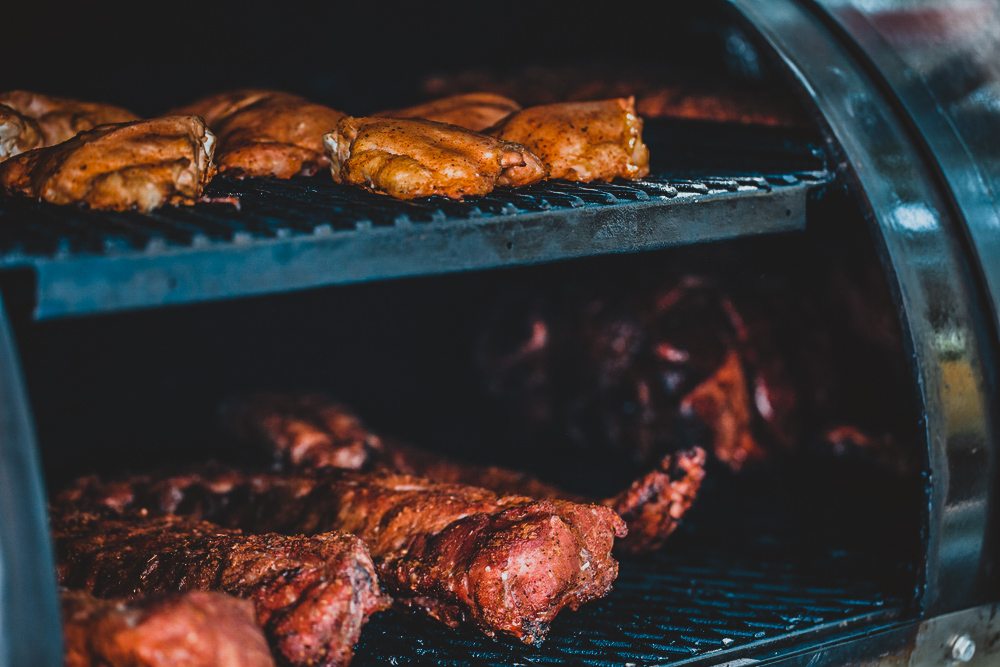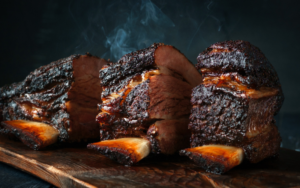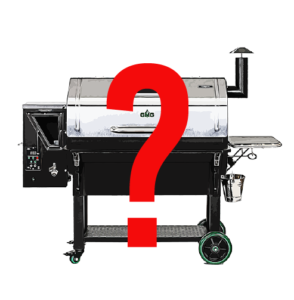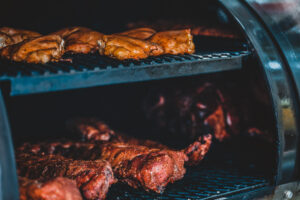5 reasons why pellet grills are better than gas grills
A gas grill is great for grilling. It can reach high temperatures quickly and maintain that temperature efficiently. You can achieve professional sear marks to accompany a beautifully cooked New York strip. To simply state a pellet grill is better than a gas grill is unfair.
It’s unfair because each grilling system serves a specific purpose. A pellet grill can grill, and some brands have options for open flame searing, but to make a blanket statement with no context is irrational. If we objectively put a pellet grill against a gas grill in “grilling”, the gas grill has the edge.
However, this is my opinion and we all know about opinions…everyone has one. This article serves to point out the versatility of pellet grills. This is for the person who is deciding to buy a pellet grill versus a gas grill. It comes down to what you want out of a grill.
Is a pellet grill better than a gas grill? It could be, and for these reasons…
1. Maintenance is straight forward
Any grilling system needs some type of routine maintenance. If not done, the grill will not operate as you expect. This leads to frustration and the overall experience will be negative. Pellet grills have made the task of maintaining a grill easy.
With features like ash and pellet clean outs, grease management, and purge functions pellet grills nearly maintain themselves. A typical pellet grill needs the following items routinely checked.
- The pellet hopper must always contain clean dry hard wood pellets
- The auger must be free of debris
- Ash must be cleaned from the firebox and cook chamber
- The path of travel for grease must be unobstructed, and grease bucket emptied when full
- The grill grates must be cleaned occasionally
- Wiping down the pellet grill keeps grease residue at bay
The features on the grill itself make maintenance very straightforward. It’s best to have a clear illustration of how this works in practice. Each person develops their own routine before and after a good smoke. There isn’t necessarily a set order to these items.
Hopper
It’s important that the pellet hopper is free of moisture. Ensuring that dry hardwood pellets are being fed into the firebox leads to a predictable experience. When pellets get wet they tend to swell, and the lignin that holds their shape breaks down.
This causes them to break apart easily causing a crumbly mess. As pellets crumble creating dust they risk causing a jam at or in the auger tube. Many pellet grill brands have a hopper clean out, allowing easy clean out of the hoper. For those brands that don’t the hopper is cleaned out by hand.
Auger
Pellet grills can succumb to pellet jams. This phenomenon prevents hardwood pellets from freely traveling down the auger tube to the firebox. The problem is that if the firebox is not adequately fed, the temperature cannot be maintained efficiently.
To clear a jam the pellets must be purged from the auger tube. Some pellet grills have this as a separate feature, and some require the start sequence to be initiated multiple times to drive the jam out. Severe jams, though rare, may require the removal of the auger tube to chip away at the stuck pellets. Make sure to use dry pellets to avoid this.
Ash
Ash is the byproduct of burning wood pellets. As you cook the pellet grill maintains temperature by burning wood pellets for fuel. Ash will build up in the firebox, and along the bottom of the cooking chamber.
The typical method to clean out ash is to remove the grill grates. Then remove the heat shield covering the firebox. Once that is done the bottom of the cooking chamber is exposed. Then, simply vacuum the ash out of the firebox and cooking chamber.
Though this is an easy task, it’s one thing I don’t necessarily enjoy doing. The only thing I would change on my pellet grill is the ability to have an ash clean out system.
Many newer models of pellet grills come standard with an ash cleanout drawer. Simply pull the drawer full of ashes out and dispose of them or use them in compost. It couldn’t get any easier to manage the ashes.
Grease, yes grease
A byproduct of the various food cooked on a pellet grills is sometimes grease. Regardless if you use your pellet grill to grill or to smoke or anything in between, there will be grease.
Pellet grills tend to produce less grease because the fat on meat renders more slowly and evenly absorbing back into itself. However, due to its induction properties the interior of the cook chamber tends to collect a nice film of grease.
Additionally, grease can collect if not well managed. If using your pellet grill at high heat the risk for fire is present. Emptying the grease bucket, ensuring a clear path of travel, and routine cleaning are all great tips to avoid any disasters.
Grates
Pellet grills are normally equipped with stainless steel, porcelain, or ceramic coated grill grates. Early smokers had the mesh style grill grates. No matter the style its easy to keep them clean.
I tend to leave my grates seasoned and don’t worry too much about any residual meat or grease. I lean this way because during startup most of the residual stuff is burned off.
If you want to it’s easy enough to brush it down (don’t recommend steel bristle brushes), but an even easier method is to do a burn off. To do this, set the pellet grill at 450 degrees or hotter for 10 minutes, then cool it down to your cooking temperature. Most of the remanents of the last smoke will be gone or at least easier to brush away.
2. built like a tank
I don’t mean to imply that gas grills are made cheaply, but pellet grills are made with thicker steel. What does that mean? Because a pellet grill is a smoker, one of the key elements it must possess is retaining heat. To retain heat, thicker more insulating steel is used.
Thick steel is used throughout the construction of a pellet grill. This thicker steel has more insulating properties. A combination of thick steel, induction heat, and large cooking chamber are signature to pellet grills (smokers in general as well).
To hold that thick steel, it’s common to see oversized ball bearing wheels, beefier legs, and stout handles on a pellet grill. In addition to some of the accessories, it’s also common to see stainless steel hardware. This all adds up to a grilling system that is meant to withstand years of use.
Stainless steel pellet grills offer even more durability lessening the risk of rust, or coating failure you may experience with other types. Due to pellet grill design, the auger, firebox, and induction fan are contained within the cooking chamber. This offers additional protection to the moving parts of a pellet grill.
With proper maintenance, pellet grills last much longer, often 6-10 years. Many last longer than 10 years. I can attest, that although I hate to admit, I do not regularly maintain my pellet grill. Because of its stout construction and durable components, it handles anything I throw at it.
3. Repair even a Newbie can do
The average, if not standard warranty timeframe on a pellet grill is 3 years. Some brands offer longer warranties, and some not as long. On gas grills this is much the same. Every brand has their own warranty claim, so its important to know what your grill has and covers.
Enough about warranties though, that is a separate discussion entirely. Generally, the majority of pellet grill companies have great customer service, and want nothing more than happy customers enjoying wood fired food.
If you have a part fail, a call or email to service usually yields you a replacement part. Those replacement parts are easy to replace, and even the average do it yourselfer can turn a screw.
Take a control board for example. Hypothetically, it may stop working or work ineffectively, and needs replace. Simply unplug a few wire connections, turn a few screws, take the old out, and replace with new. The same method works for many of the other parts as well.
Need to replace the auger motor? The induction fan? The igniter? All of these parts are easily replaced. This is part of the appeal of a pellet grill. You always hate to have to repair something you expect to just work, but the reality is parts wear down.
At least you have a grilling system that is designed to be easy to work on and get you back to great tasting food. There are hundreds of YouTube videos on repairs lasting just a few minutes. This is a testament to how simple and straightforward repairs and replacements are.
4. It's smart
Pellet grills have controllers that make them operate like an outdoor oven. You’ve probably heard that, but what does that mean? They are able to be announced as outdoor ovens because of their advanced logic. Pellet grills will have either a time based controller or digital controller.
A time based controller feeds pellets to the firebox at a set time interval based on the temperature you set. It works, however the temperature is more variable with this type of controller. Instead of a narrow margin of temperature like +/- 5 degrees, larger swings in temperature are experienced like +/- 25 degrees.
Most top selling pellet grills have a PID controller with a digital user interface backing it. All this means is that to you or I we set the temperature using a dial displaying a digital readout, or pushing touch screen buttons on a small LCD viewer.
PID stands for Proportional Integral Derivative. A PID controller is on most pellet grills these days and really lends to the set it and forget it versatility. I’m able to set my temperature and walk away. The pellet grill maintains the temperature I set within close margins.
This consistent heat and smoke produces consistent mouthwatering results. Because a PID controller constantly monitors through a feedback loop, pellets are burned efficiently.
This efficiency yields less smoke. Smoke is what produces the flavor, and is what we want with low and slow temperatures. Many brands have smoke control, which allows more smoke while still maintaining a narrow margin in temperature fluctuations.
All of this technology is working in the background. The outward facing user interface is simple and straightforward…as it should be. It’s great that my pellet grill has a PID controller, but I have greater comfort i knowing that if I set it at a certain temperature, its going to stick there.
As a bonus, nearly all pellet grills are paired WiFI and Bluetooth. Pellet grills connected via an app give you all the control and comfort knowing exactly what your grill is doing. You can see what temperature your grill is set at, how it’s maintaining that temperature, and even know the internal temperature of your meat is doing. Managing barbecue has never been easier and more convenient.
Knowledge drop: If you need an accurate way to optimally control a variable automatically, you implement PID technology. PID applies constant feedback control to a set function. You set the temperature of your pellet grill to 250 degrees. Based off that set function, temperature sensors give data back to the controller. The auger feeds pellets to the firebox, the fan stokes the fire, circulates the heat, and the temperature is maintained within a very close margin. +/- 5 degrees. That's impressive. You use PID technology everyday as well if you drive. Cruise control uses the same feed back control based on a set wheel speed.
5. it can grill
A pellet grill can grill. As mentioned in the beginning if put head to head with a gas grill, the gas grill would likely edge out the pellet grill. Pellet grill manufacturers have stepped up their game in recent years.
Pellet grills can bake, braise, grill, barbecue, smoke, roast…they can do many things well, which is a big advantage over a gas grill.
Gas grills can easily get to temperatures of 450 degrees or hotter. This means the grate temperature is also hot, and is what gives you that signature searing sound when a steak hits the grates.
Pellet grills can also reach those temperatures, but for alot of the brands this is the top of their temperature range. That means they may get there, but they can’t efficiently maintain or exceed that temperature. The grilling surface likely has a lower temperature and achieving that sear won’t be the same.
Many of the top pellet grill brands (GMG, Traeger, Pit Boss, Camp Chef, Recteq) all achieve high enough temperatures to sear a steak without issue. I can confirm this. I have a 6 year old GMG Jim Bowie that places a nice sear at 450 degrees. If it can sear, most anything out there today sure can.
Some of those same brands offer direct flame searing as well. This works by incorporating a sliding shutter if you will on top of the firebox. As you slide the shutter open a flame shoots up to the grilling surface.
This is great for a good sear, but is more of an advanced technique. It can be dangerous to use this method if you don’t know what you’re doing. No one wants an out of control grill fire. It takes all the fun out of a backyard barbecue.



